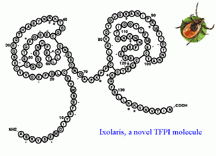Vector Biology Section
Established in 1996
José Ribeiro, M.D., Ph.D.
Chief, Vector Biology Section

Major Areas of Research
- Role of vector saliva in blood feeding by arthropods, where a great diversity of pharmacologically active compounds and new targets for vaccination against vector-borne diseases have been uncovered
- Role of saliva in blood feeding by arthropods, concentrating in transcriptomic studies of the salivary glands of insect and tick vectors of infectious diseases to discover their salivary components, from which their structure and function are studied
- Discovery and determination of mode of action of novel anti-clotting, anti-platelet, immunomodulatory, and vasodilatory agents
- Expression of novel proteins and peptides with known and unknown function
- Development of tools for transcriptome annotation
Program Description
Research in the Vector Biology Section explores the biochemical and pharmacological diversity found in the salivary glands of blood feeding insects and ticks. Molecular, biochemical, and pharmacological approaches are used in our research. Recently, we have used vector salivary gland transcriptome analysis to discover new and interesting compounds and for that reason have developed tools for bioinformatic analysis. In each of the major areas of research, we seek discoveries that improve our basic knowledge of the evolution of the blood feeding behavior, at the same time generating novel compounds that can be of pharmacological use or developed as vaccine targets. Inquiries about predoctoral and postdoctoral fellowships as well as Ph.D. studentships in the National Institutes of Health Graduate Partnership Program are welcome.

The figure shows the structure of Ixolaris, an anti-clotting protein derived from the tick Ixodes scapularis (also pictured). This protein has anti-clotting and anti-metastatic properties.
Biography
Education
M.D., State University of Rio de Janeiro
Ph.D., Federal University of Rio de Janeiro
Languages Spoken
PortugueseDr. Ribeiro received his M.D. from the State University of Rio de Janeiro and a Ph.D. from the Biophysics Institute of the Federal University of Rio de Janeiro. He was an assistant and associate professor at the Harvard School of Public Health and professor at the department of entomology in the University of Arizona before joining NIAID in 1996. His work focuses on the role of vector saliva in blood feeding by arthropods, where a great diversity of pharmacologically active compounds and new targets for vaccination against vector-borne diseases have been uncovered. Dr. Ribeiro has served for many years in the Tropical Diseases Research Program of the World Health Organization and as editor and reviewer for several journals.
Selected Publications
Barillas-Mury C, Ribeiro JMC, Valenzuela JG. Understanding pathogen survival and transmission by arthropod vectors to prevent human disease. Science. 2022 Sep 30;377(6614):eabc2757.
Mans BJ, Andersen JF, Ribeiro JMC. A Deeper Insight into the Tick Salivary Protein Families under the Light of Alphafold2 and Dali: Introducing the TickSialoFam 2.0 Database. Int J Mol Sci. 2022 Dec 9;23(24):15613.
Lu S, Andersen JF, Bosio CF, Hinnebusch BJ, Ribeiro JM. Acid phosphatase-like proteins, a biogenic amine and leukotriene-binding salivary protein family from the flea Xenopsylla cheopis. Commun Biol. 2023 Dec 18;6(1):1280.
Guizzo MG, Mans B, Pienaar R, Ribeiro JMC. A comparison of Illumina and PacBio methods to build tick salivary gland transcriptomes confirms large expression of lipocalins and other salivary protein families that are not represented in available tick genomes. Ticks Tick Borne Dis. 2023 Nov;14(6):102209.
Andersen JF, Lei H, Strayer EC, Pham V, Ribeiro JMC. Mechanism of complement inhibition by a mosquito protein revealed through cryo-EM. Commun Biol. 2024 May 27;7(1):649.
Patents
Valenzuela JG, Ribeiro JM, Barral A, Netto M, Brodskyn C, Gomes R, inventors; The United States of America as represented by the Secretary of the Department of Health and Human Services, assignee. Lutzomyia longipalpis polypeptides and methods of use. United States patent US 8,628,780. 14 Jan 2014.
Fischer LB, Valenzuela JG, Ribeiro JM, Kamhawi S, inventors; Merial Limited, The United States as represented by the Secretary of the Department of Health and Human Services, assignees. Leishmania vaccine using sand fly salivary immunogen. United States patent US 8,603,808. 10 Dec 2013.
Calvo E, Marinotti O, Ribeiro JM, Francischetti IM, inventors; The United States of America, as represented by the Secretary, Department of Health and Human Services, Regents of the University of California, assignees. Aegyptin and uses thereof. United States patent US 8,383,589. 26 Feb 2013.
Aliberti J, Anderson J, Golding H, Sher A, inventors; The United States of America as represented by the Secretary of the Department of Health and Human Services, assignee. Protozoan derived compositions and methods of use therof. United States patent US 7,510,715. 31 Mar 2009.
Valenzuela JG, Ribeiro JMC, Barral A, Netto M, Brodskyn C, Gomes R, inventors; The United States of America as represented by the Secretary of the Department of Health and Human Services, Cruz, assignees. Lutzomyia longipalpis polypeptides and methods of use. United States patent US 7,485,306. 3 Feb 2009.
Valenzuela JG, Belkaid Y, Kamhawi S, Sacks D, Ribeiro JM, inventors; The United States of America as represented by the Department of Health and Human Services, assignee. Anti-arthropod vector vaccines method of selecting and uses thereof. United States patent US 7,388,089. 17 Jun 2008.
Visit the U.S. Patent and Trademark Office for a complete patent listing.
Research Group
Role of vector saliva in blood feeding by arthropods, in particular determining the structure-function relationships of their components.

